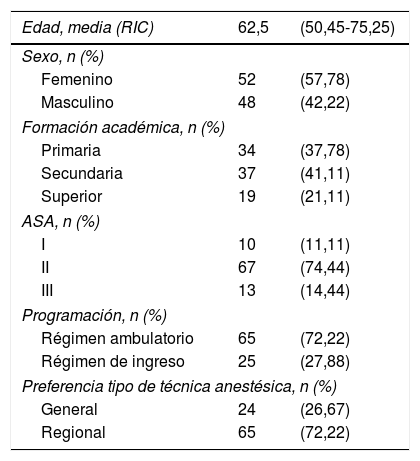La ansiedad preoperatoria puede alterar la evolución perioperatoria aumentando la necesidad de sedantes y analgésicos. La información recibida en la consulta de anestesia podría reducir el nivel de ansiedad. Nuestro objetivo fue comprobar la reducción del nivel de ansiedad tras la consulta preanestésica.
Materiales y métodosEstudio observacional, unicéntrico y prospectivo. Se registraron datos sociodemográficos y clínicos. La frecuencia cardíaca, la tensión arterial y la ansiedad mediante el State-Trait Anxiety Inventory abreviado se midieron antes y después de la entrevista anestésica. Los resultados fueron analizados mediante el test de Wilcoxon y regresiones univariables. Un valor de p≤0,05 fue considerado significativo.
ResultadosSe incluyeron 90 pacientes, con una edad media de 62 años, 58% mujeres, 79% con estudios primarios o secundarios, 72% programados para cirugía ambulatoria, y un 72% prefería anestesia regional. La prevalencia de la ansiedad fue del 35,6% (puntuación en el State-Trait Anxiety Inventory de 5; RIC 3-9), que se redujo tras la consulta a 4 (RIC 2-6); p=0,005. No hubo descenso significativo de los valores hemodinámicos ni relación entre el nivel de ansiedad y las variables sociodemográficas y clínicas.
ConclusionesLa información administrada en la entrevista anestésica logró reducir los niveles de ansiedad. Este hecho enfatiza la importancia de la consulta preanestésica en lo que a identificación y manejo de la ansiedad se refiere.
Preoperative anxiety can alter perioperative evolution, increasing the need for sedatives and analgesics. Information received during the pre-anesthesia consultation could reduce the level of anxiety. The objective of this study was to determine whether preoperative anxiety levels decrease after the pre-anesthesia consultation.
Material and methodsObservational, unicentric, prospective study. Sociodemographic and clinical data were recorded. Heart rate, blood pressure and anxiety levels were measured before and after the pre-anesthesia consultation using the abbreviated State-Trait Anxiety Inventory. Results were analyzed using Wilcoxon test and univariate logistic regression. P=.05 was considered significant.
ResultsNinety patients were included, with a median age of 62 years; 58% were females, 79% had completed primary-secondary studies, 72% were selected for ambulatory surgery and 72% preferred regional anesthesia. The prevalence of anxiety was 35.6% (State-Trait Anxiety Inventory score 5; IQR 3-9); after the anesthesia consultation the score was reduced to 4 (IQR 2-6), P=.005. There was no significative decrease in hemodynamic values, and no significant relationship between anxiety and sociodemographic or clinical variables.
ConclusionsThe pre-anesthesia consultation reduces anxiety levels in surgical patients. This emphasizes the importance of the pre-anesthesia consultation in identifying and managing anxiety.
Artículo
Comprando el artículo el PDF del mismo podrá ser descargado
Precio 19,34 €
Comprar ahora











